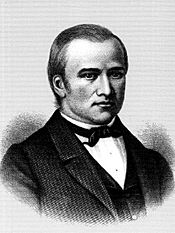Newel K. Whitney facts for kids
Quick facts for kids Newel K. Whitney |
|
|---|---|
 |
|
| Presiding Bishop | |
| June 6, 1847 – September 23, 1850 | |
| Called by | Brigham Young |
| First Bishop of the Church | |
| December 4, 1831 – June 6, 1847 | |
| Called by | Joseph Smith, Jr. |
| End reason | Called as Presiding Bishop |
| Personal details | |
| Born | Newel Kimball Whitney February 5, 1795 Marlboro, Vermont, United States |
| Died | September 23, 1850 (aged 55) Salt Lake City, Utah Territory, United States |
| Resting place | Kimball-Whitney Cemetery 40°46′22″N 111°53′22″W / 40.7728°N 111.8895°W |
| Spouse(s) | Elizabeth Ann Whitney |
Newel K. Whitney (born February 5, 1795 – died September 23, 1850) was an important leader and businessman in the early Latter Day Saint movement. He was known for his business skills and his strong support of the growing church.
Newel K. Whitney married Elizabeth Ann Smith in 1822. He owned a store and an ashery (a place that made lye from wood ashes) in Kirtland. He joined the early Latter Day Saint church in 1830.
Whitney helped the church a lot financially. He paid taxes on church property and helped pay off debts. He traveled for business and as part of his duties as a Bishop. He served as the second Presiding Bishop of The Church of Jesus Christ of Latter-day Saints (LDS Church) from 1847 until his death in 1850.
Contents
Early Life and Career
Newel K. Whitney was born in Marlborough, Vermont. He was the second of nine children. In 1803, his family moved to Fairfield, New York.
Working as an Army Supplier
In 1814, Whitney worked as an army sutler. This meant he sold supplies to American soldiers near Lake Champlain during the War of 1812. He lost everything he owned in the Battle of Plattsburgh. However, he kept working as a sutler until the army stopped fighting.
Whitney later traded furs and other goods with Native Americans. He often stopped in Monroe, Michigan, for supplies. There, he became friends with Algernon Sidney Gilbert, who owned a store.
Starting a Business in Ohio
In 1817, Whitney moved to Painesville, Ohio. He worked as a clerk for Gilbert, who taught him how to keep business records.
Life in Kirtland, Ohio
Whitney moved to Kirtland in 1819 to be with Ann Smith, whom he later married. They got married on October 20, 1822.
Building Businesses in Kirtland
In Kirtland, Whitney opened a small log cabin store around 1821 or 1822. He bought land and built a larger store called the Red Store by 1824. He also built an ashery nearby. These businesses helped the local economy in Kirtland.
Sometimes, customers would pay him with wood, which he used at his ashery. The potash made at the ashery was bought by wool carders to process wool. In 1824, Whitney expanded his ashery and built a home behind the Red Store.
After the Erie Canal was built in 1825, it became cheaper to transport goods to Kirtland. In 1826, Whitney built another store, which his family called the White Store. By 1827, he partnered with Gilbert to run a store called N.K. Whitney & Co.
Joining the Church of Christ
Newel and Ann Whitney joined the Disciples of Christ, also known as Campbellites. Their bishop, Sidney Rigdon, baptized members. Ann Whitney felt that the Campbellites did not have the authority to give people the Holy Ghost.
In 1830, Newel and Ann joined the Church of Christ (Latter Day Saints). Many of their neighbors joined around the same time. The Whitneys let their home be used for church meetings. The prophet Joseph Smith and his family even stayed with the Whitneys for several weeks.
During this time, Ann Whitney had five children. Their oldest son, Horace, was born in 1823. Horace later became the father of Orson F. Whitney, another important church leader.
Joseph Smith Lives in the White Store
Joseph Smith and Newel K. Whitney were close friends. From 1832 to 1836, Joseph Smith and his family lived in the White Store. The first School of the Prophets was held in an upstairs room there. Joseph Smith also received important revelations there, including the Word of Wisdom.
In 1832, Joseph Smith received a revelation that Whitney and other church leaders would share responsibility for taking care of the poor. This group was called the United Firm.
Whitney's Role as Bishop
In 1831, Whitney was appointed as a bishop in the church. At that time, Edward Partridge was the only other bishop. Whitney decided how to best support his local community. He continued to run his store and offered help to the poor.
In 1832, Whitney broke his leg and foot in a wagon accident while returning from Missouri. He stayed in a public house for four weeks to recover. Later that year, he was asked to visit church members in New York, Albany, and Boston.
As the church's financial officer, Whitney helped the United Firm buy over 100 acres of land in Kirtland. He paid taxes on this land. Whitney's ashery became the place where the Kirtland Temple was built, starting in 1833.
The United Firm was dissolved in 1834. Whitney helped pay off the debts that members owed to each other. He also helped Joseph Smith open a store in Kirtland. In 1835, Whitney brought his parents to Kirtland, where they met Joseph Smith and were baptized. By 1836, Whitney was regularly giving food to the poor and needy.
The Whitneys moved to Missouri in 1838, where Whitney was appointed as a bishop again. However, they soon had to move to Illinois because of persecution.
Nauvoo and Later Years
While in Nauvoo, Illinois, Whitney was involved in important church developments. He was part of a special group called the Quorum of the Anointed. This group included some of the highest-ranking and most trusted leaders of the church. Whitney's wife, Elizabeth Ann, was also part of this group.
In 1844, Whitney became a member of the Council of Fifty. When Edward Partridge died, Whitney became the First Bishop of the church. His title was changed to "Presiding Bishop" in 1847.
After Joseph Smith's death, Whitney helped manage the church's property. He was also an alderman (a city council member) in Nauvoo from 1841 to 1843. From 1846 to 1847, Whitney led church members in settling at Winter Quarters during their journey west.
In 1848, Whitney traveled to Utah. In 1849, he became the bishop of the Salt Lake City Eighteenth Ward. Whitney helped new immigrants find places to live in communities. He also helped Brigham Young plan the city of Ogden, Utah.
Newel K. Whitney died in 1850 from an illness called "bilious pleurisy." LDS Church president Gordon B. Hinckley compared Whitney's role in the early church to a Presiding Bishop today, who oversees the church's physical assets and properties.
Images for kids
See also
 In Spanish: Newel K. Whitney para niños
In Spanish: Newel K. Whitney para niños


